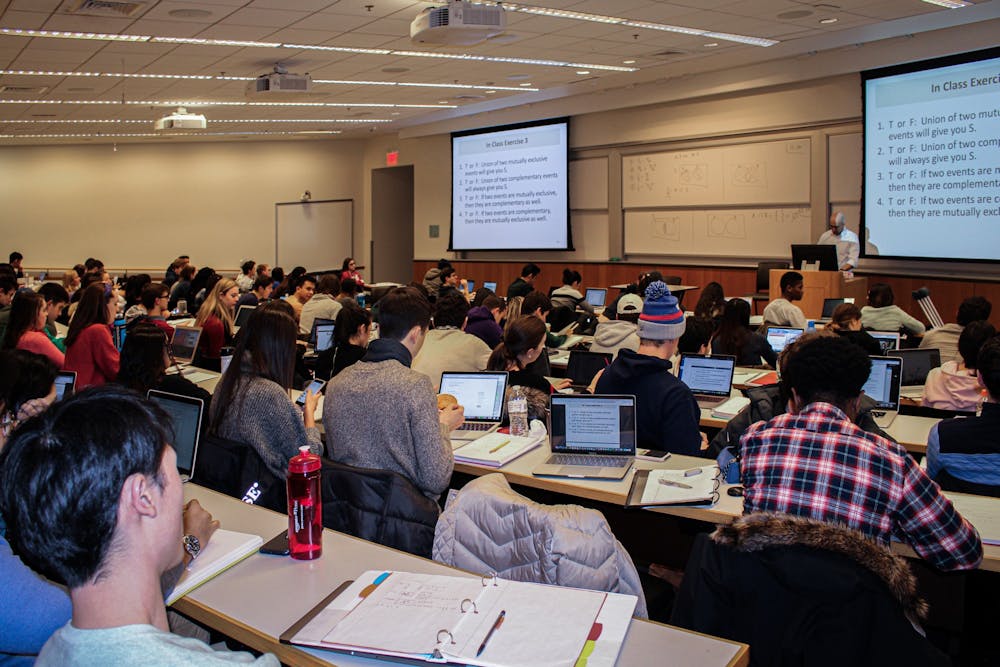
“Electronic devices are not allowed in this class.”
Many professors, at Penn and elsewhere, have a no-electronics policy for their classes. The reasons for this are numerous, and often valid. For example, paper notes have been shown to be more effective for memory retention, and the presence of electronic devices in classes can easily distract students.
However, as someone who sometimes has difficulty reading handwritten notes, this creates a barrier when I try to review for a class. I can usually read my notes, but I have messy, rushed lettering, and English is one of my two native languages, making it difficult for me to read some complicated or atypical handwriting. Usually, this issue is limited to one or two sections of notes, mostly when I’m rushed to copy down a couple of slides before the professor moves on. There is still a marked difference in how easily I can review my past notes depending on whether the notes are on paper or digital.
The usage of electronic devices in lectures makes learning more accessible for many students. Whether it’s because English is a second language, or because students have difficulties with reading or writing quickly due to other diagnoses, tablets, and laptops make the process of taking notes easier and less stressful for many. Nonnative speakers, for example, may not have the time to understand what lecturers say due to the rush to write it down.
But what if just the students who experience these difficulties receive special accommodations to use electronics in class?
Accommodations like these publicize a private condition, where there is no real justification to do so for a student’s safety. Hypothetically, if a student struggles with dyslexia or dysgraphia, and they were the only one allowed to use devices in a lecture, other students would inevitably notice the accommodation. Much like how the Americans with Disabilities Act aims to protect the privacy of people’s conditions, this also is a student’s private matter that we need to protect. Herein lies the difficulty in only granting permission to students with disabilities or other barriers.
Thus, many professors at Penn must either decide to remove devices completely from the learning environment or to allow students to access them with universal rules. It is best for students to be allowed devices for accessibility, but in the case that professors still find it preferable to ban them, there are additional measures that can help. There are different approaches to these rules, each one with their own strengths and weaknesses.
Some professors attempt to keep students attentive and engaged while still allowing them to access their devices. A perfect balance is difficult to achieve, but there are some policies that help.
One common policy is for professors to allow only tablets or only laptops, but not phones, since the former are not optimized for distracting software like chat messaging and social media. Professors could also have rules about being on nonacademic sites or distracting other students during lecture.
Another policy is to integrate interactive content in lectures. Studies show that while handwriting one’s notes is generally more effective than typing them out, interactive learning where students engage with the content is even more effective than lecture-style teaching itself. While allowing students to take their notes electronically, professors could also minimize the amount of actual time students spend on their devices and potentially getting distracted by having them hold discussions, ask questions, and participate in simulations or games.
If professors do decide to ban students from electronics, it’s important to have safeguards that help students learn without requiring them to take meticulous notes every class. Some classes, in fact, are impossible to do well in without virtually copying down every topic and example discussed, simply because there aren’t enough alternate accessible resources.
Providing ample online class notes is one solution, for example. Presentation slides for classes that actually include answers to the questions posed, a small summary of the content covered in class, which readings to review to understand the material better, or even just a set of page ranges of the textbook in which the concepts are explained are also extremely beneficial to one’s academic experience.
Every course at Penn has a unique topic and a unique way the lecturer teaches it — something I personally appreciate for how interesting it makes every class. However, there are simple steps that professors and other teaching staff can take to make learning much more accessible to every student, in every class.
To guarantee immersion and engagement, course content needs to be accessible. We must recognize the daunting barriers that some course policies and restrictions create, and act on them as necessary.

ACE DAHYEON CHOI is a Wharton and Engineering junior studying economics and computer science from Seoul, South Korea. Her email is dhachoi@seas.upenn.edu.
The Daily Pennsylvanian is an independent, student-run newspaper. Please consider making a donation to support the coverage that shapes the University. Your generosity ensures a future of strong journalism at Penn.
Donate



